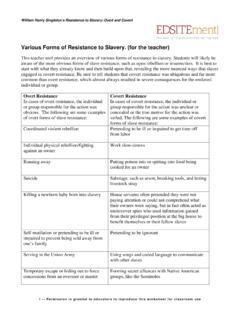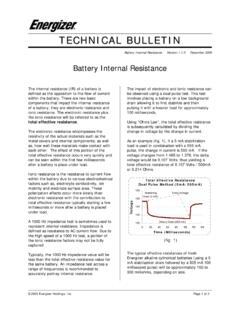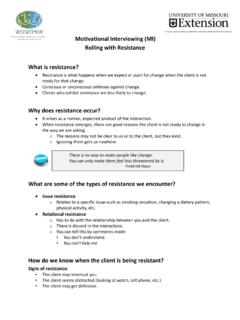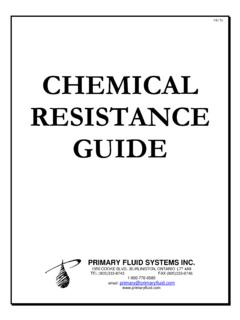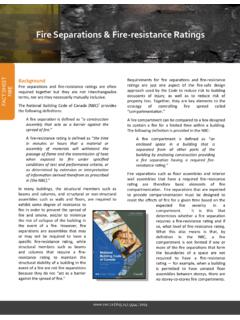Transcription of 12 Pesticide resistance - Integrated Pest Management
1 Pesticide resistance is an important concept to understand when attempting to manage a pest. Without taking actions to delay or minimize pest resistance now, the Pesticide Management tactics we currently use may someday no longer work. 1In this presentation we will explore what Pesticide resistance is and how it occurs. We will also look at resistance to insecticides, fungicides, and herbicides, and how to manage resistance so pesticides can continue to be used as crop Management tools in the future.[Pictures from top to bottom: Western and northern corn rootworm adults (page 53, Corn Field Guide), gray leaf spot on corn (page 28, Corn Field Guide),marestail(horseweed) is resistant to the herbicide glyphosate(page 53, Weed ID Guide).]2A population of pests in a crop production field can be made up of different biotypes of the pest organism. A biotype of an organism is the same species, but has genetic variances.
2 For example, dogs are a single type of organism, but there are many different types of dogs. This is due to genetic variation within the dog species, Canus lupus familiaris. Genetic variation allows for Labrador retrievers, Siberian huskies, poodles, bulldogs, and many other kinds of dogs. A pest organism can also have different genetics within the same species. For an example, green foxtail (page 35, Weed ID Guide), has a variant called purple robust foxtail. This natural genetic difference within a pest species can allow some members of the species to survive a Pesticide application. Pesticides damage or prevent specific processes in an organism that are required for life and a genetic difference may protect the organism from damage due to the Pesticide . The surviving members of that population are resistantto the , Pesticide resistance is the natural ability of a biotype of an organism to survive exposure to a Pesticide that would normally kill an individual of that species.
3 This occurs with insects, fungi, weed, and other pests. 3 Pesticide resistance at a population level, as opposed to just a few individual pests within a species, can occur after repeated exposure to a single type of Pesticide . This is because only the resistant organisms are left to reproduce with other resistant organisms. The new resistant biotype (with the natural ability to survive a Pesticide exposure) then becomes the dominant biotype of the pest population. This is why planting a refuge of susceptible corn along with Bt corn is important: so that some biotypes of the susceptible pest survive and mate with the resistant organisms, delaying the ability of the pest to develop a resistant population. When a resistant population occurs, the Pesticide is no longer useful for managing that specific pest and other Management options must be sought , if pest resistance is managed effectively, a Pesticide can remain useful for growers to continue using into the one type of Pesticide over and over again can produce resistance in a population of insects, fungi, weeds, or other organisms.
4 For example, lets say that the screen represents a corn field that is infested with green worms feeding on the corn plants. (CLICK FORWARD) First, the grower decides to spray a certain chemical to get rid of those worms. The Pesticide will kill the majority of green worms (CLICK FORWARD), but there may be some part of the population that is not affected by the chemical, just as in humans some chemicals may affect certain people whereas those same chemicals may not affect other people. These unaffected worms are represented above in red. Let s say that out of thousands and thousands of green worms a few have the genetic ability to survive the Pesticide application. These worms keep on eating corn plants and can eat as much as they want because most of the competition they had in the field is now dead and the insecticide has not killed them. The surviving worms are not killed by a subsequent application of the same chemical and reproduce (CLICK FORWARD).
5 Offspring have the same genetic composition as their parents and are able to withstand the insecticide. The insecticide is no longer useable as a viable method of pest Management for this organism since the surviving biotype is now resistant to the Pesticide (CLICK FORWARD). Even though this example is greatly sped up from what occurs in real life, it illustrates how pest organisms can overcome are used to control insect pests. Insect resistance to the synthetic insecticide DDT was documented in 1947 and since that time, key pest organisms have been found with resistance to new insecticides within 2 20 years of a pest becomes resistant, the insecticide is used more frequently and the insecticide must ultimately be replaced as insect control diminishes. Even in plant types of insecticides such as the insecticidal protein Bt can be overcome by insects!
6 Simply put, rotation of Management practices is essential to keeping current pest control tools page 13 of the Soybean Field Guide 2ndEdition for some alternatives to insecticide applications and page 26 of the Corn Field Guide for things to consider before using an insecticide. For Pesticide stewardship information, see pages 14 17 of the Soybean Field Guide 2ndEdition.[Pictures from top: Soybean aphids (pages 38 40, Soybean Field Guide 2ndEdition) and adult moths of the European corn borer (page 54, Corn Field Guide).]6 There are several ways that insects can become resistant to the effects of pesticides. The first is called metabolic. Metabolic resistance occurs when the insect can clear it s body of a toxin, or break a toxin down more quickly than the other insects of its site resistance occurs when the insecticide can no longer connect at it s target site at a molecular level in the insect.
7 Penetration resistance is when the insects shell more slowly absorbs an when certain insects can sense or steer clear of insecticide dangers, it is called behavioral are used to manage plant diseases caused by fungal organisms. Fungi are highly diverse and may be able to adapt to repeated fungicide sprays. Because of this, resistance Management may become an issue. The first fungicides were sulfur and copper based. Mercury fungicides were developed in the early 1900s and were widely used until it was discovered that they were highly toxic to animals. In the 1940s and '50s, fungicides like Captan and Maneb were introduced. All of these fungicides are contact fungicides and only work if applied prior to infection. These older fungicides have another important characteristic: they affect a number of different metabolic sites within the fungus so fungicide resistance has never been a concern.
8 More recently, highly effective compounds with specific modes of action have been developed. In other words, these fungicides affect one specific site in one metabolic pathway of the fungus. The exactness of the action of these products means that fungi only have one barrier to overcome. Thus, the problem of fungicide resistance has occurred and is on the increase since growers have relied more and more on these newer fungicides. So, although newer fungicides represent marked improvements in performance, including systemic and therapeutic properties, these compounds are prone to resistance because of their specific mode of action. It is important to protect the newer, more effective groups of fungicides because resistance may lead to unexpected and costly crop losses to growers, and loss of a valuable fungicide page 12 of the Soybean Field Guide 2ndEdition for alternatives to foliar fungicide applications and page 23 of the Corn Field Guide for things to consider before using a foliar fungicide.
9 For Pesticide stewardship information, see pages 14 17 of the Soybean Field Guide 2ndEdition.[Pictures from top: Eyespot (page 31, Corn Field Guide) and northern leaf blight (page 30, Corn Field Guide) on corn leaves.]8 Herbicides are used to kill first cases of resistant weeds were documented in the 1950s. Since that time, many other weeds have been found that show resistance to herbicides. Today, there are only a few herbicide products that are used to manage weeds, so it is expected that weed resistance will become an increasing problem. See page 8 of the Weed ID Guide for more details on herbicide page 6 of the Weed ID Guide for things to consider when selecting herbicides.[Pictures from top: Wild parsnip (page 44, Weed ID Guide) and poison hemlock (page 42, Weed ID Guide).]9 The first cases of resistant weeds were documented in the 1950s.
10 Since then there has been a dramatic increase in the number of biotypes becoming resistant to herbicides. For more information on herbicide resistant weeds go here of June 2010, several weeds have shown resistance to different types of herbicides in Iowa. The row beneath the Type of herbicide heading shows some of the different types of herbicides. Brand names of herbicides fall into one of these categories or another, non listed category. For example, Roundup and Touchdown are EPSPS inhibitors. ALS inhibitors include FirstRate , Option , and Resolve the left hand column we see some common names of weeds listed and the next columns mark whether or not populations of that weed have exhibited resistance to a type of herbicide. Common cocklebur (page 58, Weed ID Guide), common lambsquarters (page 67), common sunflower (page 54), common waterhemp (page 41), giant foxtail (page 33), giant ragweed (page 49), marestail (page 53), and shattercane (page 36)


